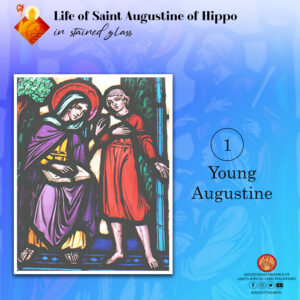Augustine was born in Tagaste, Souk-Ahras, Algeria on November 13, 354 to Patricius, a pagan, and Monica, a fervent Catholic. He was endowed with abundant human and intellectual gifts as well as an inquisitive mind and a passionate spirit, all of which brought him great pain at times, while leading him to great discoveries about himself, life, and God, as well.

Through the generosity of a family friend he was able to do studies beyond the basic course in his hometown, and became an accomplished rhetorician and teacher in Africa and later in Rome and Milan. Though he had been admitted to the catechumenate of the Catholic Church by his mother as a child, he did not find satisfaction in the Church during adolescence and young adulthood, and instead was drawn to other forms of spiritual expression, especially in the Manichean sect and later in astrology.
Finally, he embraced skepticism. In retrospect, however, he was able to discern various moments of spiritual growth or conversion until a final climactic moment when he decided to embrace Christ fully in the Catholic Church. He had already separated from the woman with whom he had lived for many years and who bore him a son, and was preparing for marriage with another, but his conversion, he felt, required that he abandon altogether any possibility of marriage and commit himself instead to a life of chastity as a celibate ‘servant of God’. Following baptism in Milan in 387, together with his son and some friends, he returned with them to his hometown of Tagaste to begin a monastic life. Against his personal wishes, he was ordained priest in Hippo in 391, and became bishop of that See in 397, all the while continuing in his monastic lifestyle.
Augustine was a prolific writer, an accomplished preacher, a monastic leader, a theologian, pastor, contemplative, and mystic. He died on August 28, 430 at almost 76 years of age, as North Africa was being invaded by the Vandals and the Church there was being devastated. His remains were taken to Sardinia and later to Pavia, Italy, where they are now preserved in the Basilica of San Pietro in Ciel d’Oro.
Saint Augustine was “an eminent member of the body of the Lord.” In company with his friends he decided to establish a type of religious life inspired by the early community of Jerusalem. He did this first as a layman at Tagaste and then at Hippo as a priest and later as bishop in accord with the rule established by the holy apostles. This ideal of the servants of God, their knowledge, continence, and profound poverty, spread through the north of Roman Africa, where many of his followers served as clerics in the Christina communities.
The formulation of this way of life experienced by him has been passed on to us through his writings, especially the Rule and those documents that refer to his conception of the monastic life. For this reason, our Order from its very beginning has recognized him as its father, master, and spiritual guide, not only because it has received the Rule and the name of the Order from him, but also because it has received from him its doctrine and spirituality (from the Constitutions of the Order of Saint Augustine Part I, Chapter I, verse 2).
© All Rights Reserved 2023 | Province of Santo Niño de Cebu - Philippines